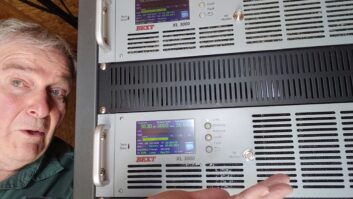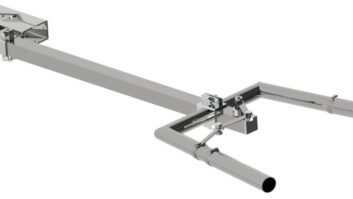There was a puzzle I recall seeing many years ago.
It was a picture of a dozen or so colorful elves printed across four separate cards. When you arranged the cards in a different order, at first glance it looked like the same elves in different positions. Upon closer inspection, though, you discovered there was now one less elf than when you started! Where did the extra elf go?
It turned out to be a clever optical illusion, relying on the viewer’s natural tendency to perceive complete figures where the artist had in fact given you only selected pieces.
When I started looking carefully at the new channel plan for the 450/455 MHz RPU band, I thought I was seeing a new version of that old puzzle. Something seemed to be missing, as you can verify from the accompanying figure. The figure shows how channels are allocated in the 1.0 Megahertz of spectrum between 450 and 451 MHz; the same plan is repeated from 455 to 456 MHz.
If you add up the spectrum occupied by a total of 102 channels of 6.25 kHz each, 10 channels of 25 kHz each, and two of 50 kHz each, you get 987.5 kHz, not 1000 kHz.
(click thumbnail)
Does the figure omit any channels? No, these are taken straight out of Part 74 the FCC Rules (as modified Nov. 13, 2002, by the Report and Order in ET Docket No. 01-75), as the citations show. Yet, somehow there is 12.5 kHz unaccounted for.
Can you see where the 12.5 kHz elf went?
Stacking question
Lest you think I have too much time on my hands, I should say that I discovered this in the course of helping an SBE member figure out how to solve a somewhat more relevant (if less amusing) problem.
He wished to license a narrow-band telemetry link, using channels at the edge of the band that are reserved for this purpose. Like most such systems, his hardware requires 10 kHz of bandwidth, necessitating the use of two stacked channels. The rules permit this, stating that when “an even number of channels are stacked … channel assignments may be made for the frequency halfway between those listed.”
So, for example, to stack the channels at 450.01875 and 450.0250, one would simply enter a center frequency of 450.021875. No problem, right? Except that when my correspondent tried to enter that frequency into the online Form 601 application, he found that only five decimal places were accepted. Oops!
A call to the helpful Steve Buenzow at the FCC in Gettysburg, Pa. – where the Wireless Telecommunications Bureau handles BAS license applications, among other things – shed light on the problem.
It should come as no surprise to learn that it is “simply” a computer programming error. The underlying database has no problem tracking those last five Hertz, but whoever created the data-entry interface did not anticipate the need to enter a frequency to that resolution.
If the problem is not fixed by the time you read this, it should be corrected soon. Until it is, Buenzow says applicants who run into this problem should enter as many decimal places as the form allows, then attach an exhibit showing the actual desired center frequency and explain channel-stacking as the reason.
The application processors have been alerted to this situation, and applications handled in this way should not run afoul of the system.
Read those rules
As for the practice of requesting stacked channels in an application, that process is designed to be automatic, based on the requested center frequency and bandwidth (as defined in the emission designator). That explains why there is no place to indicate channel stacking in Form 601. Given that most channels are now defined in 6.25-kHz increments, and no known equipment actually operates in such a narrow channel, channel stacking will take place more often than not.
Buenzow cautions that applicants unfamiliar with the recent revisions to Part 74 rules would do well to read carefully sections 74.402 and 74.462 before applying for new licenses or major modifications in the 450/455 MHz band. I would add: Be sure to check your emission designator for consistency with both your equipment and the bandwidth of the channel(s) for which you are applying.
Now, what about the missing 12.5 kHz?
There actually are four unassigned slivers of 3.125 kHz each, which an astute reader can find by careful scrutiny of the figure shown.
Start by observing that the first center frequency is 450.00625, or 6.25 kHz away from the edge of the band. Spectral efficiency would seem to require that the center of a 6.25-kHz-wide channel should be only 3.125 kHz from the band edge. This same anomaly occurs at the top edge of the band. Two similar anomalies occur where the narrow channels abut the wider ones. Together, four wasted half-channels add up to 12.5 kHz – more than enough for another signaling channel.
One wonders whether the center frequencies were chosen this way to keep the number of decimal places to a minimum: 450.00625 MHz as opposed to 450.003125 MHz, for example. If so, the plan must have backfired on the FCC as soon as someone (like my correspondent) tried to stack two channels and arrived at a center frequency the Web form would not accept!
Send your comments or questions to David Otey, CSTE, at [email protected].













